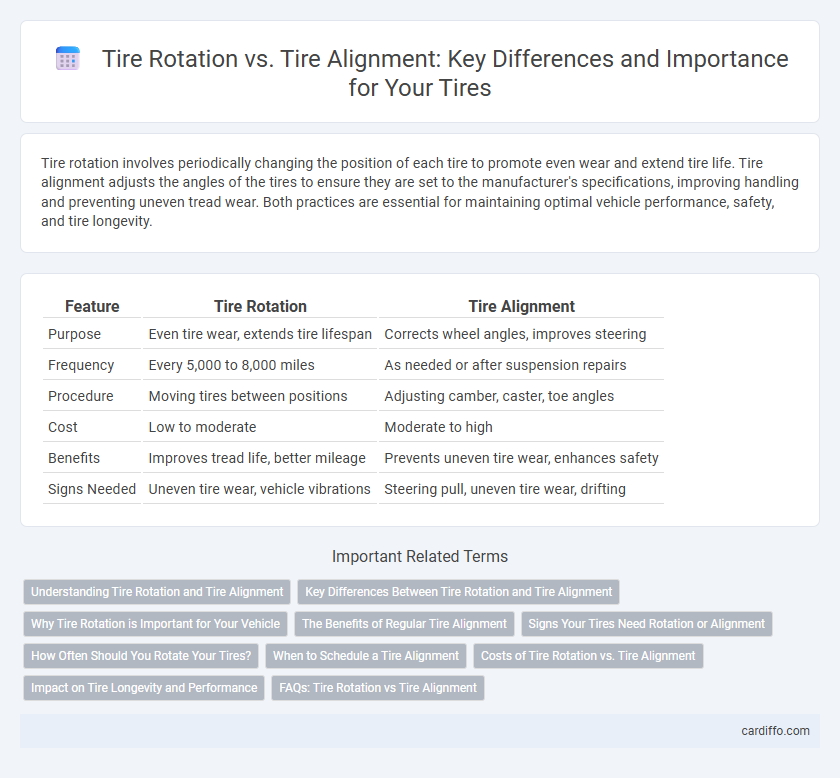Tire rotation involves periodically changing the position of each tire to promote even wear and extend tire life. Tire alignment adjusts the angles of the tires to ensure they are set to the manufacturer's specifications, improving handling and preventing uneven tread wear. Both practices are essential for maintaining optimal vehicle performance, safety, and tire longevity.
Table of Comparison
| Feature | Tire Rotation | Tire Alignment |
|---|---|---|
| Purpose | Even tire wear, extends tire lifespan | Corrects wheel angles, improves steering |
| Frequency | Every 5,000 to 8,000 miles | As needed or after suspension repairs |
| Procedure | Moving tires between positions | Adjusting camber, caster, toe angles |
| Cost | Low to moderate | Moderate to high |
| Benefits | Improves tread life, better mileage | Prevents uneven tire wear, enhances safety |
| Signs Needed | Uneven tire wear, vehicle vibrations | Steering pull, uneven tire wear, drifting |
Understanding Tire Rotation and Tire Alignment
Tire rotation involves periodically changing the position of each tire to ensure even wear and extend tire lifespan, typically done every 5,000 to 8,000 miles. Tire alignment adjusts the angles of the tires to the manufacturer's specifications, improving handling, fuel efficiency, and preventing uneven tread wear. Regular tire rotation maintains balanced wear patterns, while proper tire alignment ensures optimal vehicle performance and tire longevity.
Key Differences Between Tire Rotation and Tire Alignment
Tire rotation involves systematically changing the position of tires on a vehicle to ensure even tread wear, typically recommended every 5,000 to 8,000 miles. Tire alignment adjusts the angles of the wheels--camber, caster, and toe--to the manufacturer's specifications, improving handling and preventing uneven tire wear. While rotation extends tire life, alignment corrects steering and suspension issues for optimal driving performance.
Why Tire Rotation is Important for Your Vehicle
Tire rotation is essential for maintaining even tire wear, which extends the lifespan of your tires and improves fuel efficiency. Regular rotation balances traction and handling by ensuring all tires wear uniformly, enhancing vehicle safety and performance. Neglecting tire rotation can lead to uneven tread wear, reducing tire effectiveness and increasing the risk of blowouts.
The Benefits of Regular Tire Alignment
Regular tire alignment ensures even tire wear, extending tire lifespan and improving fuel efficiency. Proper alignment enhances vehicle handling and safety by maintaining optimal contact with the road. This maintenance reduces strain on suspension components, lowering long-term repair costs.
Signs Your Tires Need Rotation or Alignment
Uneven tire wear, such as bald spots on one side or excessive tread wear in specific areas, signals the need for tire rotation or alignment. Vibrations while driving and a vehicle pulling to one side often indicate misaligned tires requiring realignment. Regularly checking tire tread depth and monitoring steering responsiveness help identify when rotation or alignment services are necessary to ensure optimal tire performance and safety.
How Often Should You Rotate Your Tires?
Rotating your tires every 5,000 to 7,500 miles ensures even tread wear and extends tire lifespan. Tire rotation balances the wear caused by different driving forces on front and rear wheels, while alignment adjusts the angles for optimal contact with the road. Following your vehicle manufacturer's recommendations and checking rotation during oil changes maintains performance and safety.
When to Schedule a Tire Alignment
Schedule a tire alignment when you notice uneven tire wear, steering wheel vibrations, or your vehicle pulling to one side, as these signs indicate misaligned wheels. Regular tire alignment every 12,000 to 15,000 miles helps maintain proper handling, extends tire life, and improves fuel efficiency. Unlike tire rotation, which redistributes tire wear, alignment adjusts the angles of the wheels to the manufacturer's specifications for optimal performance.
Costs of Tire Rotation vs. Tire Alignment
Tire rotation typically costs between $20 and $50, making it a more affordable routine maintenance task compared to tire alignment, which ranges from $75 to $100 or more due to its complexity. Regular tire rotation helps extend tire life by promoting even tread wear, while tire alignment corrects the angles of the tires to prevent uneven wear and improve vehicle handling. Investing in tire alignment can save money in the long run by avoiding premature tire replacement and enhancing fuel efficiency.
Impact on Tire Longevity and Performance
Tire rotation evenly distributes wear by changing tire positions, enhancing tire longevity and maintaining balanced traction across all wheels. Tire alignment corrects the angles of tires relative to the vehicle frame, preventing uneven wear patterns and improving handling performance. Both practices are essential for optimizing tire life and ensuring consistent, safe driving conditions.
FAQs: Tire Rotation vs Tire Alignment
Tire rotation involves periodically changing the position of tires on a vehicle to ensure even tread wear and extend tire life. Tire alignment adjusts the angles of the tires to the specifications set by the manufacturer, enhancing handling and preventing uneven tire wear caused by misalignment. Regular tire rotation is typically recommended every 5,000 to 8,000 miles, while alignment should be checked during tire changes or if the vehicle pulls to one side or the steering wheel vibrates.
Tire rotation vs tire alignment Infographic

 cardiffo.com
cardiffo.com